The purpose of water treatment is to cleanse drinking water to satisfy federal government guidelines for quality and produce wastewater effluent that has a minimized effect on the environment. Water and wastewater treatment plants (WWTPs) use different phases to speed up the natural processes that purify water and wastes. Whatever methods, equipment, or technologies are used, pumps are a necessary element for moving raw water, waste water, sludge, and effluent within various processes. With high global demands for energy, the industry is looking for pumping systems that take full advantage of performance, reliability, and cost-effectiveness.
Decreases in pump efficiency can be caused by mechanical, volumetric, and hydraulic losses. Mechanical loss is related to moving elements of a pump, such as bearings and glands. Volumetric loss refers to leakage of fluid from the discharge side of the pump to the suction side. Hydraulic loss is triggered by the frictional forces developed in between the fluid and the walls of the hydraulic passage, velocity, and the modification of the fluid direction. Therefore, smooth pump walls reduce circulation variations and, subsequently, the energy required for the pump to move the fluid. This post goes over the use of state-of-the-art lining innovations to increase the performance of pumps while protecting their internal surfaces from disintegration and deterioration.
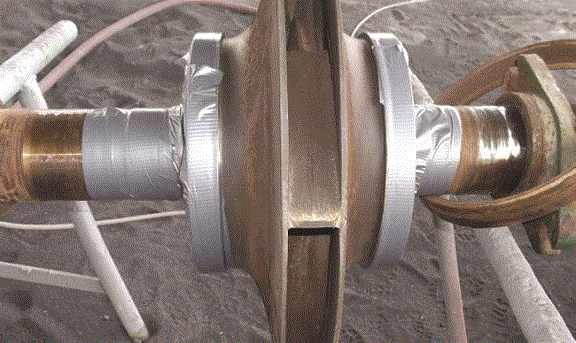
Result of Pump Surface Roughness
The two categories of pumps most typically used at WWTPs are the centrifugal and positive displacement pumps. Centrifugal pumps are more common since they are easy and safe to run under a broad series of conditions. The operating concept of moving a fluid by means of mechanical actions can be detrimental to the internal components of the pump. For instance, centrifugal pumps are vulnerable to damage and efficiency destruction by cavitation, where vapor bubbles form in the low-pressure region directly behind the turning impeller vanes. The collapse of these bubbles can damage the impeller and deteriorate the pump casing.5 Pressure drop control in pumps is typically limited, and cavitation can not be prevented. Over time, cavitation can produce severe erosion-corrosion issues.
The roughness of pump surfaces impacts the fluid flow.
As the roughness increases, the laminar circulation becomes unstable and shifts into rough circulation. Erosion-corrosion mechanisms are intensified under unstable circulation conditions. Surface area flaws in the form of small protrusions or anxieties, such as corrosion pits, deposits, and weld beads, can trigger disturbed flow on a smaller sized scale. Although small, such problems suffice to start the erosion-corrosion processes in the form of impingement, cavitation, and even entrainment in the presence of solid particles.6 Under these situations, energy losses will occur and lead to more decrease in effectiveness of the pumping system.
Alternatives for Pump Efficiency Improvements.
Standard options to mitigate the unfavorable repercussions of turbulent flow programs include devices design adjustments to reduce hydrodynamic forces and using exotic, erosion-resistant alloys as materials of building and construction. However, due to cost, relieve of construction, and accessibility, the products of construction most frequently picked are cast iron, carbon steel (CS), or stainless steel (SS). The resistance of these conventional products to rust and disintegration is relatively low; and in the case of SS, localized corrosion can still take place when its protective passivation movie is damaged or exposed to chloride environments.
Another method to minimize erosion-corrosion and enhance performance is to isolate the metal surface area from its contact environment with a lining. Numerous benefits of this option can be mentioned:8.
1. Lining pumps made of CS with fit-for-service coatings provides an economical approach of improving the rust resistance of standard materials when compared to using corrosion-resistant alloys or cladding.
2. Lining products are readily offered if needed, even at short notice.
3. Lining products do not add substantial weight to the pumps. Sometimes, linings can facilitate a reduction in weight because of a reduced corrosion allowance for the metal based upon lower awaited disintegration and deterioration rates.
4. Efficient lining application methods enable much shorter project preparations and less equipment downtime.
A wide variety of corrosion-resistant coating innovations can be used for securing the interiors of pumps. Some of them include glass flake, thermosetting polyurethane, and nonsolvent-free epoxy coatings. Making use of a few of these coatings is limited by the presence of volatile organic substances (VOCs) in their structure, which may trigger health and safety issues. Others have bad mechanical adhesion and lowered resistance to erosion and rust. Due to technological advances in protective commercial linings and repair composite materials, it is now possible to utilize polymeric materials for coating systems with exceptional resistance to erosion-corrosion and cavitation. These high-technology linings can efficiently boost pump efficiency.
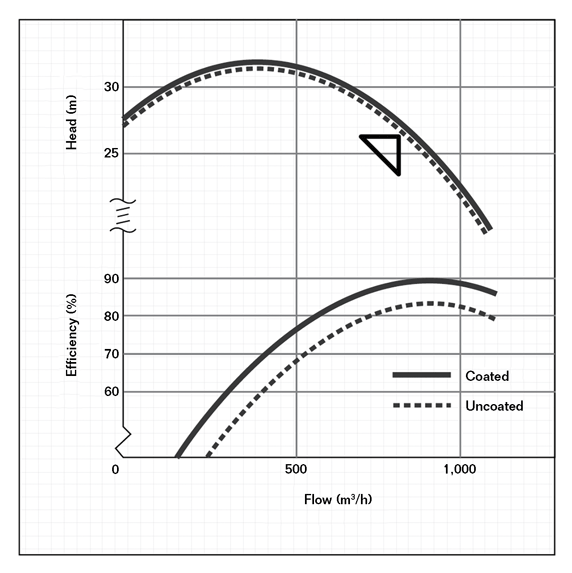
Coatings Designed with a Unique Combination of Properties.
Pump efficiency curve.State-of-the-art coating innovation has resulted in coatings with special chemistry. Enhanced erosion-corrosion resistance, hydrophobicity, and hydraulic smoothness are qualities that allow high energy effectiveness and optimum pump efficiency to be achieved. These coatings are essentially created as a blend of lube agents and abrasion-resistant fillers. The fillers are utilized to reduce erosion-corrosion wear, whereas a mix of various amines offers a smooth finish and low electronic affinity towards water molecules. As a result, the beginning of rough circulation is delayed, which consequently lowers skin friction.
These coatings are solvent-free, epoxy-based, and free of VOCs so health and wellness concerns are minimized and item shrinkage is avoided. Coating systems can be applied in fairly thin layers to circumvent any flow restriction issues. Linings have been reported with a surface roughness of 0.09 µm vs. 1.19 µm for polished SS. The ultra-smooth surface, in addition to self-levelling and hydrophobic properties, lessen turbulence and surface area tension.
These high-performance coatings were tested for service physical fitness in alignment with globally recognized approaches such as those supplied by ISO, NACE International, and ASTM. Such coatings have actually reported adhesion worths greater than 31 MPa (4,500 psi) on grit-blasted moderate steel when tested in accordance with ASTM D45419 and ISO 4624.10 Atlas cell testing, in accordance with NACE TM0174,11 is likewise utilized to figure out the suitability of these coatings in immersion service. Chemical testing using ISO 2812-112 is another test required for assessing the resistance of coatings to the range of chemicals found in the WWTP. Some of these chemicals include chlorine, ferric chloride (FeCl3), and sodium hypochlorite (NaClO).
In addition, these protective coatings can be checked for potable water contact in agreement with the U.K. Drinking Water Inspectorate.
Pump Efficiency.
The efficiency of a centrifugal pump is normally explained by a graph that plots the pressure produced by the pump over a series of flow rates (determined in terms of head). Likewise, its performance is consisted of on a common pump performance curve. The effectiveness of a pump is the ratio of the pump’s fluid power to the pump shaft power. A centrifugal pump has a best effectiveness point (BEP) where it runs the most cost-effectively in regards to both energy effectiveness and upkeep. Continually running a pump at its BEP is difficult due to the fact that systems typically have changing demands.4.

A pump efficiency test in 1989– carried out by the National Engineering Laboratory (then part of the United Kingdom’s Department of Trade and Industry), a global reference in fluid circulation screening that represents the most thorough pump test facilities worldwide– recognized performance enhancement of a centrifugal pump that was lined.14 The tests were carried out in a single stage, end-suction centrifugal pump with 10-in (254-mm) suction and discharge branches. The pump (in an uncoated condition) performed at 1,300 rpm, had a capability of 875 m3/h (5.55 countless gallons per day [mgd] at 26.5 m head, and total peak performance of 83.5%.14 The exact same pump was then protected with a lining to demonstrate that boosted pump effectiveness could be attained.
The coating examined was a solvent-free, two-component epoxy system, specially developed for improving the performance of fluid-handling devices and securing metal surfaces from the effects of erosion-corrosion. This coating was used in 2 colors to validate the 2nd coat had actually been evenly used and completely covered the first coat, and to make future assessments much easier to assess. The two pump tests were carried out in a normal closed-loop system using the same protocol, with a series of flow, head, and power readings taken throughout a wide circulation range. The pump effectiveness curve, developed with calibrated test instrumentation and traceable to nationwide requirements, was then plotted (Figure 1).
FIGURE 3 Erosion-corrosion results to the impeller.
Checking results of the covered pump showed a 6% increase at peak performance (Figure 1). Substantially, there was little change to the pump head/flow characteristics, meaning the coating increased the pump performance while maintaining the original head/flow properties. The power decrease of 5.1 kWh was attained at responsibility point.
History.
A state federal government water and wastewater treatment business in Bahia, Brazil employed a lining to safeguard a centrifugal pump and increase its performance. This water and wastewater business is responsible for operating and keeping 431 water treatment systems and 94 wastewater plants throughout more than 360 municipalities in Bahia. The water treatment plants supply drinking water for 11.9 million individuals, whereas the wastewater plants provide sanitation to ~ 4.8 million people.15.
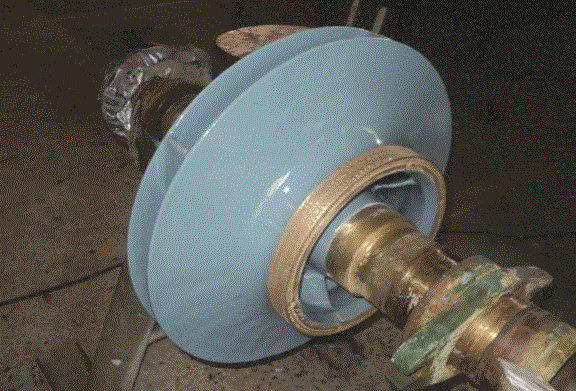
.In 2006, the plant maintenance personnel of among these plants discovered anomalies in their process, primarily due to mechanisms of erosion-corrosion and cavitation in the pumping system. The possession, a Worthington † split-case centrifugal pump with a capability of 1.080 m3/h (6.84 mgd), was installed in the pump system to catch raw water from the São Francisco River for treatment and shipment to the neighborhood. This pump was experiencing localized metal loss and corrosion, mostly in the volute case and impeller (Figure 3). Numerous repair options were thought about by the asset owner. The choice was made to utilize a 100% solids epoxy-based lining to secure the harmed internal parts of the pump. The work was performed by authorized applicators following the lining maker’s product guidelines for usage, as follows:.
– The malfunctioning parts were abrasive blasted to achieve surface cleanliness requirements of NACE No. 2/SSPC-SP 1016 and ISO 8501-1 (Sa 2 1/2),17 with a minimum typical profile of 3 mils (75 µm).
– The surface areas were checked for salt contamination and dealt with accordingly.
– The surfaces were washed down with appropriate cleaner/degreaser to remove residual blasting debris and any grease impurities.
– The thickness of the pump wall was restored according to the original equipment producer’s pump repair standards using paste-grade epoxy products.
– The protective coating was by hand applied in 2 coats of contrasting colors to obtain a minimum total dry movie density.
– The lining was allowed to cure for chemical service (Figures 4 and 5) and more inspected for connection.
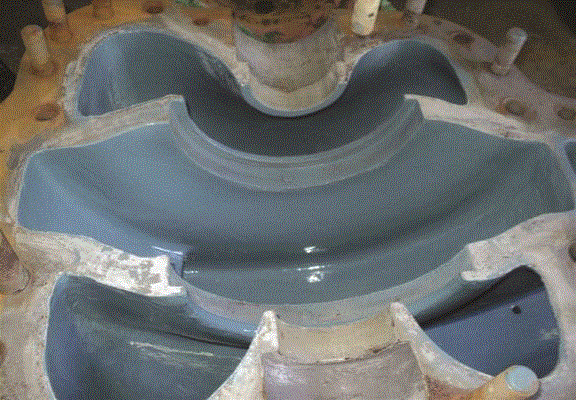
Results
The pump was returned to service. After 6 years of continuous use, the pump was opened for evaluation by upkeep workers. Some erosion wear and metal loss from moderate cavitation could be seen on the volute surface area (Figure 6), but the lining remained in good condition. The plant supervisors were satisfied with the results. The pump had been protected against cavitation and corrosion for 6 years. The procedure is now part of their preventive upkeep program.
The pump likewise was tested to examine both the energy intake and the cost of power intake savings associated with running a more efficient pump. Direct measurement of motor current was chosen to properly evaluate improvement of the pump’s effectiveness. Electric current readings were taken on the motor of an uncoated and covered pump under the exact same conditions. The readings for the uncoated pump revealed an average of 72 A with 440 V, whereas readings reported an average of 66 A for the layered pump. The results showed an amperage decrease of 8.33% and a consequent reduction in the power usage, because these variables are directly proportional.
These outcomes showed that this coating technology efficiently added to decreasing losses by safeguarding the surface versus the impacts of erosion-corrosion and cavitation. Creating a smooth, hydrophobic finish also resulted in a reduction in energy consumption. Ever since, the exact same efficiency-enhancing polymeric coating was applied to eight of the 12 pumps at that pump station. The results can be reproduced for other types of pumps.
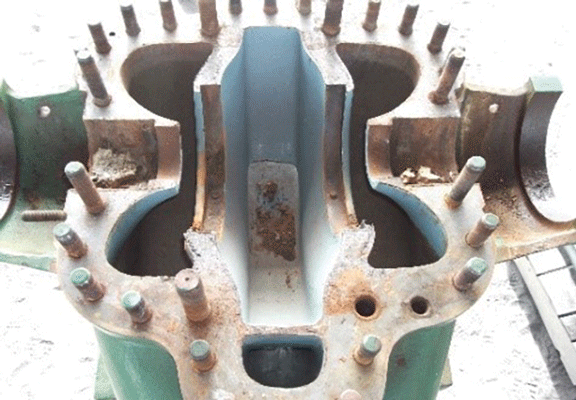
Conclusions.
The polymeric coating innovation proved to be a suitable alternative for improving the performance of the pump, as well as protecting it from deterioration, with very little maintenance work throughout its designated life time. The technology is recommended for protecting pump surface areas and boosting pump effectiveness within water and wastewater plants.
As anticipated, cavitation effects were not eradicated however minimized; nevertheless, the boost in fluid flow efficiency represented an instant saving in power usage, one of a lot of significant business expenses for water and wastewater treatment plants.

